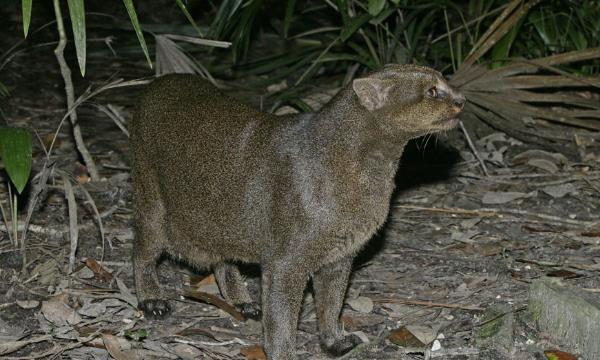Herpailurus yaguarondi
IUCN
LCBasic Information
Feature
The fur has no spots and is very uniform in color, ranging from black to brownish gray (gray scale), or from fox red to chestnut (red scale).
Distribution and Habitat
Origin: Argentina, Belize, Bolivia, Brazil, Colombia, Costa Rica, Ecuador, El Salvador, French Guiana, Guatemala, Guyana, Honduras, Mexico, Nicaragua, Panama, Paraguay, Peru, Suriname, Venezuela, Bolivarian Republic of.
Possibly extinct: United States (Texas).
The slender-waisted cat lives in lowland scrubland near running water and occasionally in dense equatorial areas.
Appearance
The Jaguarundi is 50-77 cm long, with a tail length of 33-61 cm and a weight of 4.5-9 kg. The species has short legs and an otter-like face; it is slender, with a small, flat head, a pair of small eyes that are close together, and a pair of small ears. Its slender body is supported by four thin legs that are not too long, and the long tail makes it look more like a weasel. The ears are short and rounded. The fur is spotless and the color is very uniform, and it changes from black to brown-gray (gray scale) or from fox red to chestnut (red scale). The two color scales were once thought to represent two different species; the gray scale was called "Jaguarundi" and the red scale was called "Eyra". However, they are the same species, and both color scales may appear in the same litter. Its fur has no other stripes except the spots at birth. This species is closely related to the puma, based on their similar genetic makeup and chromosome numbers; both species are in the
Details
The slender-waisted cat (scientific name: Herpailurus yaguarondi) is also known as Jaguarundi and Eyra Cat in foreign languages. There is only one species in this genus, namely the slender-waisted cat. It is a medium-sized wild cat. In some Spanish-speaking countries, the slender-waisted cat is also called "Leoncillo", which means "little lion".

The slender-waisted cat and other small cats in South America may be more closely related to the continent's big cats than to the continent's other small cats, because they have 38 chromosomes like those big cats (cougars and jaguars), rather than 36 like those small cats. Their ancestors may have followed the ancestors of the mountain lions and walked all the way from Eurasia through the Bering Strait. Perhaps they are the descendants of the primitive mountain lions in modern times.
The cat can breed all year round, but the main mating season is generally in September and November each year. After a gestation period of 70-75 days, the mother cat usually gives birth to 1-4 cubs. After about a month, the cubs are weaned. But it takes 24-36 months for them to fully mature sexually. Similar to lions and cougars, cat babies are also covered with spots when they are born, and as they grow up, the spots will gradually fade. In addition, "children" of different generations may continue to live with their parents. Even without children, adult cats may wander around and hunt in pairs. The gestation period is 70-75 days, with 1-4 cubs per litter, and sexual maturity at 2-3 years old. The life span of wild cats is 15 years.
The number of cats in their distribution area is still relatively optimistic. But it is rare in Mexico and Central America. Because they also hunt poultry raised by humans, this brings them to their own death. Except for Brazil, Nicaragua, Ecuador, El Salvador and Guyana, other regions have banned hunting. Because the fur of the slender-waisted cat is not very good, it is not good-looking and uncomfortable to touch, so it escapes human hunting. But due to the increasing deforestation and habitat loss, their future is still worrying. CITES lists the slender-waisted cat in Appendix II, but the four subspecies living in North America and Central America are listed in Appendix I.
Listed in the 2015 Red List of Endangered Species of the World Conservation Union (IUCN) ver 3.1-Least Concern (LC).
Listed in Appendix I, Appendix II and Appendix III of the Convention on International Trade in Endangered Species of Wild Fauna and Flora (CITES) 2019 Edition.
Protect wild animals and eliminate game.
Maintaining ecological balance is everyone's responsibility!








